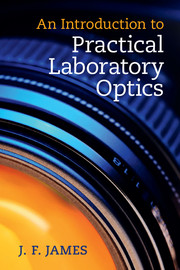Book contents
- Frontmatter
- Contents
- Preface
- 1 Introduction: centred optical systems
- 2 Telescopes and binoculars
- 3 Eyepieces, eyes and colour
- 4 Cameras and camera lenses
- 5 The scientific CCD camera
- 6 Spectrometry
- 7 Interferometers and their uses
- 8 Electro-optical effects and their practical uses
- 9 Microscopes and projectors
- 10 Siderostats and coelostats
- 11 The detection and measurement of radiation
- 12 Practicalities
- Appendix A Gaussian optics
- Appendix B Optical aberrations
- Appendix C A brief introduction to Fourier optics
- Further reading
- Index
7 - Interferometers and their uses
Published online by Cambridge University Press: 05 October 2014
- Frontmatter
- Contents
- Preface
- 1 Introduction: centred optical systems
- 2 Telescopes and binoculars
- 3 Eyepieces, eyes and colour
- 4 Cameras and camera lenses
- 5 The scientific CCD camera
- 6 Spectrometry
- 7 Interferometers and their uses
- 8 Electro-optical effects and their practical uses
- 9 Microscopes and projectors
- 10 Siderostats and coelostats
- 11 The detection and measurement of radiation
- 12 Practicalities
- Appendix A Gaussian optics
- Appendix B Optical aberrations
- Appendix C A brief introduction to Fourier optics
- Further reading
- Index
Summary
Interferometry
Interferometers, as the name implies, rely on the wave nature of light and of the constructive and destructive interference between wave-trains. They are devices, often of great ingenuity, with many applications to fine measurement (~10−9 m) or ultra-fine measurement (~10−12 m) and as such they have led the way to many advances in science, not least in provoking the theory of relativity and in confirming the predictions of quantum mechanics. After overcoming formidable technical problems in construction and stability, interferometers are now in everyday use, particularly in spectroscopy, fine measurement and quality control.
Oscillation, phase and phase-difference
The word ‘oscillator’ applies as much to the electric vector of a beam of radiation as it does to a swinging pendulum. Two oscillators are ‘in phase’ when they reach a maximum displacement in the same direction at the same time and are ‘out of phase’ if their displacements are exactly opposite. We then say that their phase-difference is 180° or that they have π radians phase-difference. Their phase-difference is measured as an angle because it is convenient to use the mathematics of a circle to do so: there are no physical lines or angles involved.
Information
- Type
- Chapter
- Information
- An Introduction to Practical Laboratory Optics , pp. 84 - 103Publisher: Cambridge University PressPrint publication year: 2014
